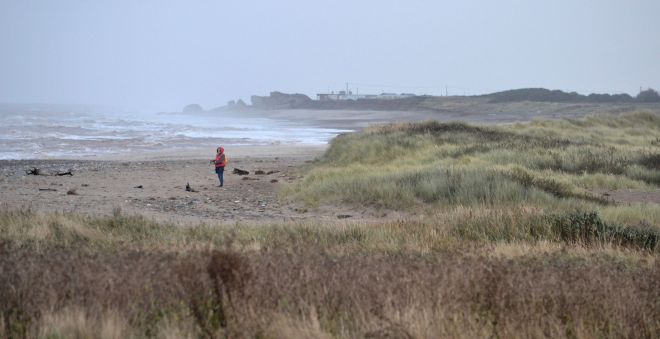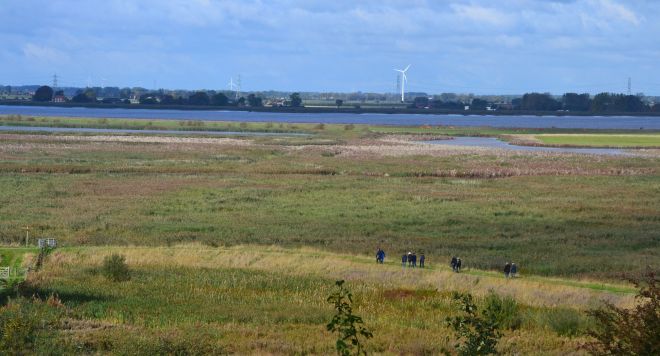In the end I had to go. Having negotiated favourable (I hope) part-time working arrangements with my latest employer, these two days would be free. So I decided to travel beyond 200 miles for the second time this month and see the East Yorkshire Siberian Accentor at Easington.
When Wednesday morning came I searched for overnight accommodation on-line, finding a single en-suite room in a well-reviewed Hull B&B for £40. The first SA sighting appeared on RBA just before 8am and I made the booking immediately. Next I fired off a few texts to Oxon birding colleagues and some quick replies came back. “Well worth it” (Badger) … “It’s gotta be done!” (Andy) and … “Welcome to the dark side” (Clackers). Then, fortified for the journey by the usual selection of CDs with oomph – The Cult, Aerosmith and the top hatted one, of course – I headed up north.
It didn’t take long to hit the first snag, a road closure on the A43 at Towcester that necessitated the same diversion via Buckingham that Mike and myself had made four days earlier. Soon after joining the M1 I experienced the 50mph variable speed limit stretch, through road works with no work actually going on, that I had read about in some of Ewan’s blog posts. But once past the M6 interchange, with my Japanese tin can’s cruise control set to 70 mph, the miles sped past until I reached the port city of Kingston-upon-Hull. After that, as I had been warned it’s another 40 minutes or so mostly through low speed limits to the village of Easington.

“Are you lot all looking at me?”
I arrived on-site at around 2pm, and there in a weedy strip of land between the outer and inner security fences of the natural gas terminal was the prize (above) I’d seen a few trillion pictures of over the previous four days. Collins describes Siberian Accentor as a shy bird that keeps mostly in cover, and that’s exactly what this extreme vagrant did for the two hours that I stayed here. 50 metres or so away was the private garden in which many of these pictures (see here) must have been taken last Friday. I must assume that the preference then for feeding openly amongst the moss there may be less typical behaviour.
As I say fairly often, I will not be submitting the images (below) for any awards, but they convey exactly how this bird was observed today and how well camouflaged it was in this habitat. In short it was an exceptional rarity in a quite unattractive place. As a spectacles wearer, the double line of security fencing (mesh then electric) through which I had to follow the bird’s movements was particularly distracting. But the bold head pattern, with broad and long buff supercilium and black cheeks, always stood out and the visitor was undeniably a cracker!
This was not the only mega at Easington yesterday. About a half-mile walk from the first spot an Isabelline Wheatear had been present all day in a ploughed field behind the coastline. A middle eastern breeder that should winter in sub-Saharan Africa, a record number of these have also turned up in the British Isles this week. As I walked down to the second location (TA407186), no parking signs were out in force. Local residents, having already experienced the year’s top mass twitch, were clearly wary of another invasion.

North Sea coast at Easington
Initially, tired from my day’s exertions, I could not locate this bird by myself. But as soon as more birders arrived … well they found it for me straight away. This is a pale-toned Wheatear, very similar to a female Northern Wheatear but slightly larger and with a more upright stance. One diagnostic of a shorter tail with broader black band was quite apparent as this individual moved around on the brown earth here. It is a species I added to my life list on Cyprus’ Akamas peninsula in April 2012, but have always wanted to remove all doubt about since that bird was self found. Comparing my pictures then to today’s first winter bird in the RBA gallery (see here) confirms that historic record.

2012 adult Issy Wheatear in Cyprus
I slept very soundly overnight. This morning there was no sign of the Siberian Accentor that must have waited for me to drop in and then gone on it’s way. What a nice mega! Elsewhere a sixth bird for Britain turned up in the Hebrides. The Easington individual was the first ever on the mainland, hence the mass twitch that occurred after it’s arrival a week ago on the afternoon of 13th. Since then further SAs have occurred at Saltburn, Cleveland; in Sunderland and on Holy Island. And across north-eastern Europe an amazing 91 had been logged by 18th in Scandinavia, the Baltic countries, Germany and Poland. It is not yet understood what has caused this irruption, but prolonged easterly winds out of the western end of their breeding range is a factor and more birds are anticipated.
The plan for today (20th) was to visit the now resident Western Purple Swamphen across the Humber Bridge in north Lincolnshire. I have been asked by other Oxon birders why I went for the Least Sandpiper in Devon on 1 August instead of this bird when it first arrived on these shores. The answer is that the former was a lifer whilst WPS, also a national first if accepted, is a British list addition for me. But there’s nothing wrong with those given reason to be nearby, hence the double agenda for this week’s trip up north.

Lincs Wildlife Trust’s Alkborough Flats NR
I have observed Swamphen many times previously on the Iberian peninsula, where I knew the species by the alternative name of Purple Gallinule. Having experience of wetlands there I could see exactly why this individual should chose to make its home in the large expanse of Alkborough Flats at the confluence of the rivers Trent and Humber. I also wondered whether it might have considered there was a little too much going on at its initial stopping place, the one time birding mecca now family fun park of RSPB Minsmere in Suffolk. That would be a sentiment I share entirely and was another reason for not going there in August.
The on-site information boards explain that the present Alkborough Flats, formerly arable land has been created as part of the Environment Agency’s flood risk management strategy for the Humber estuary. A breach in the sea defences allows water to be stored over one-third of this 1000 acre site during extreme high tide events and so helps to reduce flooding in places such as Hull, Gainsborough and York. In the process new mud flat and saltmarsh habitats are developing naturally to the benefit of wildlife, and other areas are being turned into grasslands and reed beds.
The Gallinule / Swamphen’s favoured location can be scanned from a signposted viewing area (SE883221) across a field from one reserve car park (pictured above). Many visiting birders have had to content themselves with distant sightings from this location on a low escarpment above the flats. But today the bird had been reported from the hide at the western end of the lagoon in the vista. I could see people inside and decided to go down, the question being what was the best route. Oops, definitely not this way (pictured below)! Oh dear, there must have been another clash of interests here between green clad optics carriers and the local property owning elite. Well. this is a private road.

When I walked around by the permitted paths, I couldn’t see the cited access point anyway. There was a second car park about 300 metres from the hide and a hard track between the two. The plaintive pinging of Bearded Tits was issuing from the reed beds here as I went along. On reaching the hide I didn’t want to be the irritating (to me) type that walks straight in and asks: “Any sign of the whatever,” without even looking. So I sat down and scanned around until a lady to my right said: “It’s coming out again now.”
There on the far side of the lagoon the Purple Swamphen / Gallinule was moving from right to left along the reed edge in all it’s blue, red and white splendour; just as I had seen them do so often in the Algarve and Coto Donana. In the archive picture from 2014 included above, the pose is identical. I only needed to tick this bird for blighty and did not linger too long here. Marsh Harriers were quartering the reed beds and on the way back to my vehicle the habitat seemed to be alive with Bearded Tits that would burst out in groups and fly around to the delight of onlookers. They are always a nice bird to see.
With two British list additions in addition to the lifer, my agenda for this trip was now complete. The satnav took me back to God’s own county (Oxon) by the M69 / A46 / M40 route that was much better than the outward journey. And so I arrived back home in the late afternoon feeling as shattered as I had anticipated, but all this had been well worthwhile.









